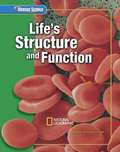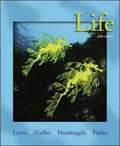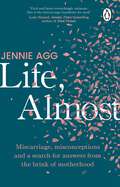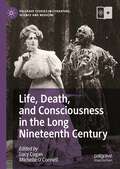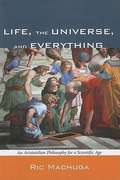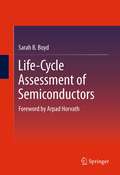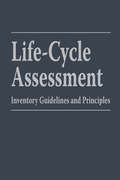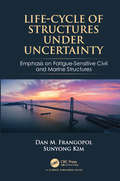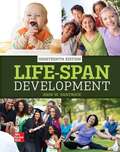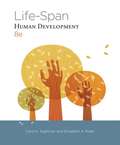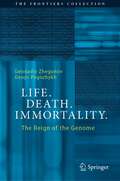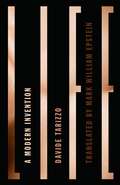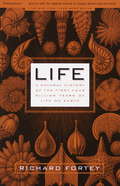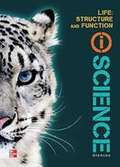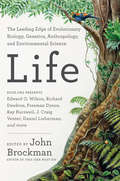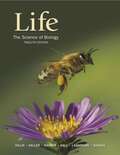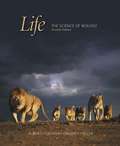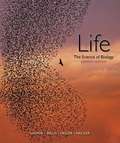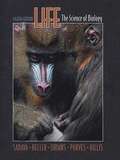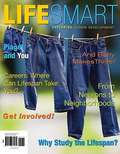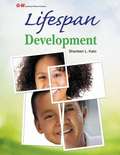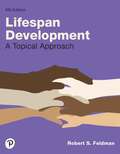- Table View
- List View
Life's Structure and Function
by McGraw-HillDiscover the flexibility to teach science your way Life's Structure and Function,as a part of the Glencoe Science 15-Book Series, provides students with accurate and comprehensive coverage of cells and cellular processes. The strong content coverage integrates a wide range of hands-on experiences, critical-thinking opportunities, and real-world applications. The modular approach allows you to mix and match books to meet your curricula.
Life, 5th edition
by Bruce Parker Marielle Hoefnagels Douglas Gaffin Ricki LewisIntroduction to Biology textbook.
Life, Almost: Miscarriage, misconceptions and a search for answers from the brink of motherhood
by Jennie Agg'Vital and heart-wrenchingly intimate' Leah Hazard'Urgent, fascinating and thought-provoking' Julia Bueno'Thoughtfully researched and beautifully written' Pippa VosperAfter losing four pregnancies with no obvious cause, Jennie Agg set out to understand why miscarriage remains such a profoundly misunderstood, under-researched and under-acknowledged experience.Part-memoir, part-scientific investigation, Life, Almost documents Agg's path to motherhood and her search for answers. Tracing each tentative step of her fifth pregnancy - as her body becomes a creature she does not wish to spook - Agg dismantles the myths that we unquestioningly accept about our reproductive lives:· Why are we told miscarriage can't be prevented when half of all miscarriages are of perfectly healthy embryos?· Why is it normal not to tell anyone you're pregnant for the first three months? · Why don't we know why labour starts? Drawing on pioneering research and interviews with world-leading experts, Life, Almost is a ground-breaking book that will change how you think about miscarriage, and a moving reflection on grief and love at the edge of life as we understand it.
Life, Death, and Consciousness in the Long Nineteenth Century (Palgrave Studies in Literature, Science and Medicine)
by Lucy Cogan Michelle O’ConnellThis book explores how the writers, poets, thinkers, historians, scientists, dilettantes and frauds of the long-nineteenth century addressed the “limit cases” regarding human existence that medicine continuously uncovered as it stretched the boundaries of knowledge. These cases cast troubling and distorted shadows on the culture, throwing into relief the values, vested interests, and power relations regarding the construction of embodied life and consciousness that underpinned the understanding of what it was to be alive in the long nineteenth century. Ranging over a period from the mid-eighteenth century through to the first decade of the twentieth century—an era that has been called the ‘Age of Science’—the essays collected here consider the cultural ripple effects of those previously unimaginable revolutions in science and medicine on humanity’s understanding of being.
Life, the Universe, and Everything: An Aristotelian Philosophy for a Scientific Age
by Ric MachugaHas modern science made philosophy obsolete? Is the soul real? Do we have a free will? Why should we be moral? Does God exist, and if so, why is there so much pain and suffering in the world? What is the relation between faith and reason? - Ric Machuga takes a holistic approach to these questions. No philosophical idea, no matter how small, can live alone. Ideas always gain their force, power, and life from their surroundings--their "ecosystem." The ecosystem of ideas defended in this book comes from the ancient Greek philosopher Aristotle and his medieval interpreter, Thomas Aquinas. The ongoing relevance of their philosophical thought to twenty-first century issues is opened up in fascinating ways. Life, the Universe, and Everything is the product of thirty years of teaching introductory courses in philosophy. Assuming no prior background, it only requires of readers an enquiring mind and a willingness to think carefully. An ideal guide to the big questions we face.
Life-Cycle Assessment of Semiconductors
by Sarah B. BoydLife-Cycle Assessment of Semiconductors presents the first and thus far only available transparent and complete life cycle assessment of semiconductor devices. A lack of reliable semiconductor LCA data has been a major challenge to evaluation of the potential environmental benefits of information technologies (IT). The analysis and results presented in this book will allow a higher degree of confidence and certainty in decisions concerning the use of IT in efforts to reduce climate change and other environmental effects. Coverage includes but is not limited to semiconductor manufacturing trends by product type and geography, unique coverage of life-cycle assessment, with a focus on uncertainty and sensitivity analysis of energy and global warming missions for CMOS logic devices, life cycle assessment of flash memory and life cycle assessment of DRAM. The information and conclusions discussed here will be highly relevant and useful to individuals and institutions.
Life-Cycle Assessment: Inventory Guidelines and Principles
by Mary Ann Curran Battelle Memorial InstituteLife-Cycle Assessment presents a brief overview of the development of the life-cycle assessment process and develops guidelines and principles for implementation of a product life-cycle inventory analysis. The book describes inventory analysis, impact analysis, and improvement analysis-the three components of a product life-cycle assessment. It discusses the major stages in a life cycle, including raw materials acquisition, materials manufacture, final product fabrication, filling/packaging/distribution, and consumer use and disposal.
Life-Cycle of Structures Under Uncertainty: Emphasis on Fatigue-Sensitive Civil and Marine Structures
by Dan M. Frangopol Sunyong KimLife-cycle analysis is a systemic tool for efficient and effective service life management of deteriorating structures. In the last few decades, theoretical and practical approaches for life-cycle performance and cost analysis have been developed extensively due to increased demand on structural safety and service life extension. This book presents the state-of-the-art in life-cycle analysis and maintenance optimization for fatigue-sensitive structures. Both theoretical background and practical applications have been provided for academics, engineers and researchers. Concepts and approaches of life-cycle performance and cost analysis developed in recent decades are presented. The major topics covered include (a) probabilistic concepts of life-cycle performance and cost analysis, (b) inspection, monitoring and maintenance for fatigue cracks, (c) estimation of fatigue crack detection, (d) optimum inspection and monitoring planning, (e) multi-objective life-cycle optimization, and (f) decision making in life-cycle analysis. Life-cycle optimization covered in the book considers probability of fatigue crack detection, fatigue crack damage detection time, maintenance times, probability of failure, service life and total life-cycle cost. For the practical application and integration of recently developed approaches for inspection and maintenance planning, efficient and effective multi-objective optimization and decision making are presented. This book will help engineers engaged in civil and marine structures including students, researchers and practitioners with reliable and cost-effective maintenance planning of fatigue-sensitive structures, and to develop more advanced approaches and techniques in the field of life-cycle maintenance optimization and safety of structures under various aging and deteriorating conditions. Key Features: Provides the state-of-the-art in life-cycle cost analysis and optimization for fatigue-sensitive structures Provides a solid foundation of theoretical backgrounds and practical applications both for academics and practicing engineers and researchers Covers illustrative examples and recent development for optimum service life management Deals with various structures such as bridges and ships subjected to fatigue .
Life-Span Development
by John SantrockAs a master teacher, John Santrock connects current research with real-world application, helping students see how developmental psychology plays a role in their own lives and future careers. Through an integrated learning goals system, this comprehensive and chronological approach to lifespan development helps students gain the insight they need to study smarter, stay focused, and improve performance.
Life-Span Development
by John SantrockAs a master teacher, John Santrock connects current scholarship with real-world applications, helping students see how developmental psychology plays a role in their own lives and future careers. Students report that highlighting the connections among the different aspects of lifespan development helps them to better understand the concepts. The robust research foundation of this text is made accessible to students through an integrated learning goals system, resulting in a comprehensive and chronological approach to lifespan development that helps students gain the insight they need to study smarter, stay focused, and improve performance. McGraw Hill Connect’s® digital learning tools are invaluable in helping students synthesize and master the broad scope of content of the lifespan development course.
Life-Span Human Development (Eighth Edition)
by Carol K. Sigelman Elizabeth A. RiderKnown for its clear, straightforward writing style, comprehensive coverage, strong and current research-based approach, and excellent visuals and tables, this life-span development text offers a topical organization at the chapter level and a consistent chronological presentation within each chapter. Each chapter focuses on a domain of development such as physical growth, cognition, or personality, and traces developmental trends and influences in that domain from infancy to old age. Within each chapter, you will find sections on four life stages: infancy, childhood, adolescence, and adulthood. This unique organization enables students to comprehend the processes of transformation that occur in key areas of human development. Another staple of the text is its emphasis on theories and how they apply to specific topics in each chapter. This new edition also asks students to engage more actively with the content, and includes a clear focus on the complex interactions of nature and nurture in development, more integrated coverage of culture and diversity, and an exciting new media package for both students and instructors.
Life. Death. Immortality.: The Reign of the Genome (The Frontiers Collection)
by Gennadiy Zhegunov Denys PogozhykhWhat are life and death? Is it possible to understand their essence and give clear definitions? Countless books and articles have been devoted to trying to answer these intriguing questions. However, there are still no definite and generally accepted answers. The intrigue remains. And meanwhile, human attempts to vanquish death and achieve immortality continue apace.This book is an attempt to answer the eternal questions about life and death by analyzing, synthesizing, and rethinking the known facts that characterize life. The material here should be of particular interest, as it contains many hypotheses, philosophical generalizations, and well informed speculations. What is most important for life - matter, energy, or information? How are individual lives and the phenomenon of life in general related? What serves what – does the genome serve the cell or does the cell serve the genome? What is the value of life and death? Can we become immortal? The inquisitive reader will find original answers to these and other exciting questions in the pages of this stimulating book.
Life: A Modern Invention (Posthumanities #44)
by Davide TarizzoThe word &“biology&” was first used to describe the scientific study of life in 1802, and as Davide Tarizzo demonstrates in his reconstruction of the genealogy of the concept of life, our understanding of what being alive means is an equally recent invention. Focusing on the histories of philosophy, science, and biopolitics, he contends that biological life is a metaphysical concept, not a scientific one, and that this notion has gradually permeated both European and Anglophone traditions of thought over the past two centuries.Building on the work undertaken by Foucault in the 1960s and &‘70s, Tarizzo analyzes the slow transformation of eighteenth-century naturalism into a nineteenth-century science of life, exploring the philosophical landscape that engendered biology and precipitated the work of such foundational figures as Georges Cuvier and Charles Darwin. Tarizzo tracks three interrelated themes: first, that the metaphysics of biological life is an extension of the Kantian concept of human will in the field of philosophy; second, that biology and philosophy share the same metaphysical assumptions about life originally advanced by F. W. J. Schelling and adopted by Darwin and his intellectual heirs; and third, that modern biopolitics is dependent on this particularly totalizing view of biological life. Circumventing tired debates about the validity of science and the truth of Darwinian evolution, this book instead envisions and promotes a profound paradigm shift in philosophical and scientific concepts of biological life.
Life: A Natural History of the First Four Billion Years of Life on Earth
by Richard ForteyBy one of Britain's most gifted scientists: a magnificently daring and compulsively readable account of life on Earth (from the "big bang" to the advent of man), based entirely on the most original of all sources--the evidence of fossils. With excitement and driving intelligence, Richard Fortey guides us from the barren globe spinning in space, through the very earliest signs of life in the sulphurous hot springs and volcanic vents of the young planet, the appearance of cells, the slow creation of an atmosphere and the evolution of myriad forms of plants and animals that could then be sustained, including the magnificent era of the dinosaurs, and on to the last moment before the debut of Homo sapiens. Ranging across multiple scientific disciplines, explicating in wonderfully clear and refreshing prose their findings and arguments--about the origins of life, the causes of species extinctions and the first appearance of man--Fortey weaves this history out of the most delicate traceries left in rock, stone and earth. He also explains how, on each aspect of nature and life, scientists have reached the understanding we have today, who made the key discoveries, who their opponents were and why certain ideas won. Brimful of wit, fascinating personal experience and high scholarship, this book may well be our best introduction yet to the complex history of life on Earth. A Book-of-the-Month Club Main Selection.
Life: Structure and Function
by The Editors at the McGraw Hill EducationThis book explains the Life's basic structure --Cell, its functions and other related topics like levels of organization,reproduction, Genetics etc.
Life: The Leading Edge of Evolutionary Biology, Genetics, Anthropology, and Environmental Science
by Mr John BrockmanThe newest addition to John Brockman's Edge.org series explores life itself, bringing together the world's leading biologists, geneticists, and evolutionary theorists--including Richard Dawkins, Edward O. Wilson, J. Craig Venter, and Freeman Dyson.Scientists' understanding of life is progressing more rapidly than at any point in human history, from the extraordinary decoding of DNA to the controversial emergence of biotechnology. Featuring pioneering biologists, geneticists, physicists, and science writers, Life explains just how far we've come--and takes a brilliantly educated guess at where we're heading.Richard Dawkins and J. Craig Venter compare genes to digital information, and sketch the frontiers of genomic research.Edward O. Wilson reveals what ants can teach us about building a superorganism--and, in turn, about how cells build an organism. Elsewhere, David Haig reports new findings on how mothers and fathers individually influence the human genome, while Kary Mullis covers cutting edge treatments for dangerous viruses. And there's much more in this fascinating volume.We may never have all the answers. But the thinkers collected in Life are asking questions that will keep us dreaming for generations.
Life: The Science Of Biology
by H. Craig Heller David M. Hillis David W. Hall Sally D. Hacker David E. Sadava Marta J. LaskowskiThe new 12th edition of Life: The Science of Biology continues to be engaging, active, and focused on teaching the skills that students need to master the majors biology course. New pedagogical features work in conjunction with powerful updates to the online suite of materials in Achieve to support the mission of Life by teaching students the skills and understanding of experimentation and data they need to succeed in introductory biology and ultimately in their future STEM careers. Life’s potent combination of expertly crafted media, assessment, pedagogy and engagement makes this new edition the best resource yet for biology students.
Life: The Science Of Biology
by David Sadava H. Craig Heller Gordon H. Orians William K. PurvesAuthoritative, thorough, and engaging, Life: The Science of Biology achieves an optimal balance of scholarship and teachability, never losing sight of either the science or the student. The first introductory text to present biological concepts through the research that revealed them, Life covers the full range of topics with an integrated experimental focus that flows naturally from the narrative. This approach helps to bring the drama of classic and cutting-edge research to the classroom--but always in the context of reinforcing core ideas and the innovative scientific thinking behind them. Students will experience biology not just as a litany of facts or a highlight reel of experiments, but as a rich, coherent discipline.
Life: The Science of Biology
by H. Craig Heller David M. Hillis Sally D. Hacker David E. SadavaThe Eleventh Edition of Life: The Science of Biology is engaging, active, and focused on teaching the skills that students need in the majors biology course. New pedagogical features grab students' attention and give them a clear learning path through the text. Active learning is a priority throughout the text and media, giving instructors the support they need to encourage students to "learn by doing." Life continues and improves its focus on experiments and data, ensuring that students learn the skills they need to succeed in their careers. It is this potent combination of expertly crafted pedagogy and engagement that make this new edition the best resource for biology students.The Eleventh Edition of Life: The Science of Biology retains its reputation as the book with the highest quality content, clarity of language, and experimental emphasis, and the new focus and features make it a Life worth investigating.
Life: The Science of Biology (4th edition)
by H. Craig Heller Gordon H. Orians William K. PurvesThe science of biology evolves. The science classroom and lab evolve. In this edition, as always, Life: The Science of Biology evolves with them, in innovative, authoritative, and captivating ways. From the first edition to the present, Life has set the standard for being the most balanced experimentally-based introductory biology text.
Life: The Science of Biology 8th Edition
by David Sadava H. Craig Heller William K. Purves David Hillis SadavaCo-published by Sinauer Associates, Inc. , and W. H. Freeman and Company. Visit the Life, Eighth Edition preview site. LIFE HAS EVOLVED. . . from its original publication to this dramatically revitalized Eighth Edition. LIFE has always shown students how biology works, offering an engaging and coherent presentation of the fundamentals of biology by describing the landmark experiments that revealed them. This edition builds on those strengths and introduces several innovations.
Lifecycles of Pathogenic Protists in Humans (Microbiology Monographs #35)
by Wanderley De SouzaThis volume covers the most important parasitic protists that are known to infect humans. The pathogens discussed cause diseases like toxoplasmosis, malaria, cryptosporidiosis, leishmaniasis, amoebiasis, trichomoniasis, and giardiasis. Readers from microbiology will appreciate the special focus on protist cell biology. As demonstrated in several of the chapters, these parasites are characterized by peculiar structures and organelles that cannot be found in mammalian cells – even though both are eukaryotic. The book employs light and electron microscopy to display the changing morphology in various stages of parasitic development. In turn, the results are supplemented by transcriptome and proteome profiles that help to describe how these changes take place on a molecular level. Both researchers and clinicians from tropical medicine will find essential and practically applicable background information on these increasingly important pathogens.
Lifesmart: Exploring Human Development
by Lisa B. FioreBuilt on research. Proven by results. Historically, as publishers, we have worked with you as professors to review and help us publish content to meet your course needs. Over the past few years we expanded our research to truly gather a better understanding of today's students. We listened, we observed and we followed students to understand how they study, how they take notes, how they read and how they use the web. We also watched instructors prepare, teach, assess, and evaluate their students. Students told us they want more visual and interactive appeal at a less expensive price. They also strive for new ways to be more efficient in their learning. Now, with our newest M-series program, LifeSmart: Exploring Human Development, you have the opportunity to engage your students as you never have before. LifeSmart's adaptive diagnostic provides your students with the ability to assess what they know and don't know before their tests. Furthermore, LifeSmart provides Milestones, our new video and assessment program that helps bring the course material to life, so your students can witness development as it unfolds. Our research gives students current and relevant applications to their lives in a new design layout that will grab your student's attention and make serious scholarship enjoyable to read. LifeSmart fits today's students.
Lifespan Development
by Sharleen L. KatoThe book is designed to help your students understand human growth and development across the lifespan.Throughout the lifespan, people continue to develop and change physically, cognitively, socially, and emotionally.
Lifespan Development: A Topical Approach
by Robert S. FeldmanLifespan Development: A Topical Approach helps you see the big picture of development across the entire lifespan. Author Robert Feldman employs a topical approach that makes it easy to understand the scope of development within particular areas (such as social or personality development) across the full lifespan. The 5th Edition offers coverage of relevant contemporary topics, including the effects of the COVID-19 pandemic across all spheres of development. Updated chapter-opening prologues tie issues such as gender identity and homeschooling to the topics being discussed in the chapter. And updated From Research to Practice features explain how developmental research can be applied to problems such as the effects of screen time on children and palliative care.
